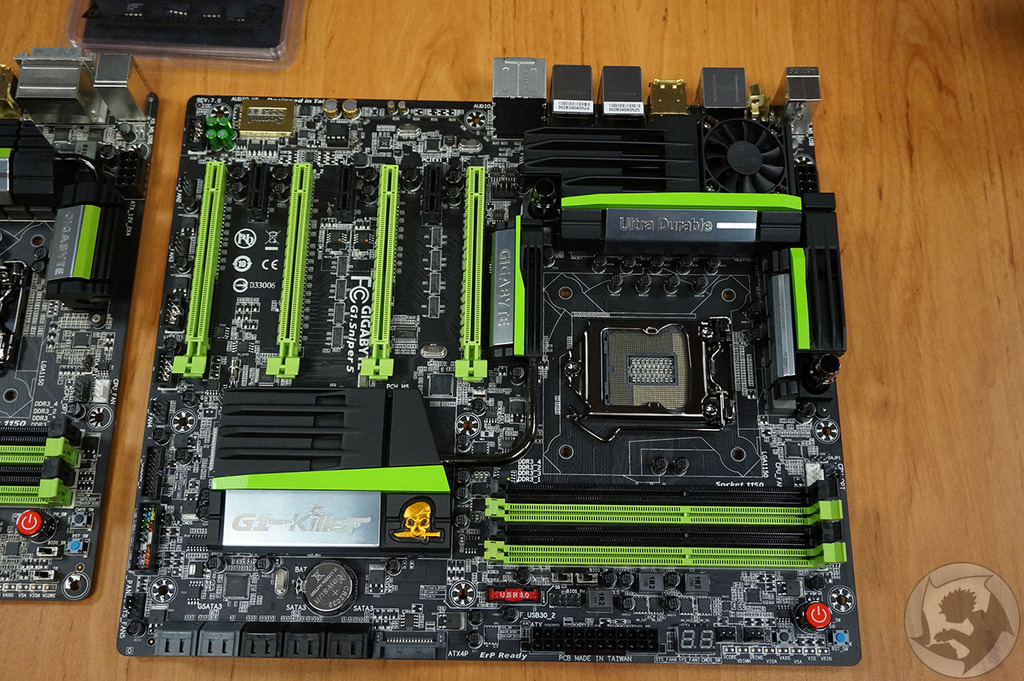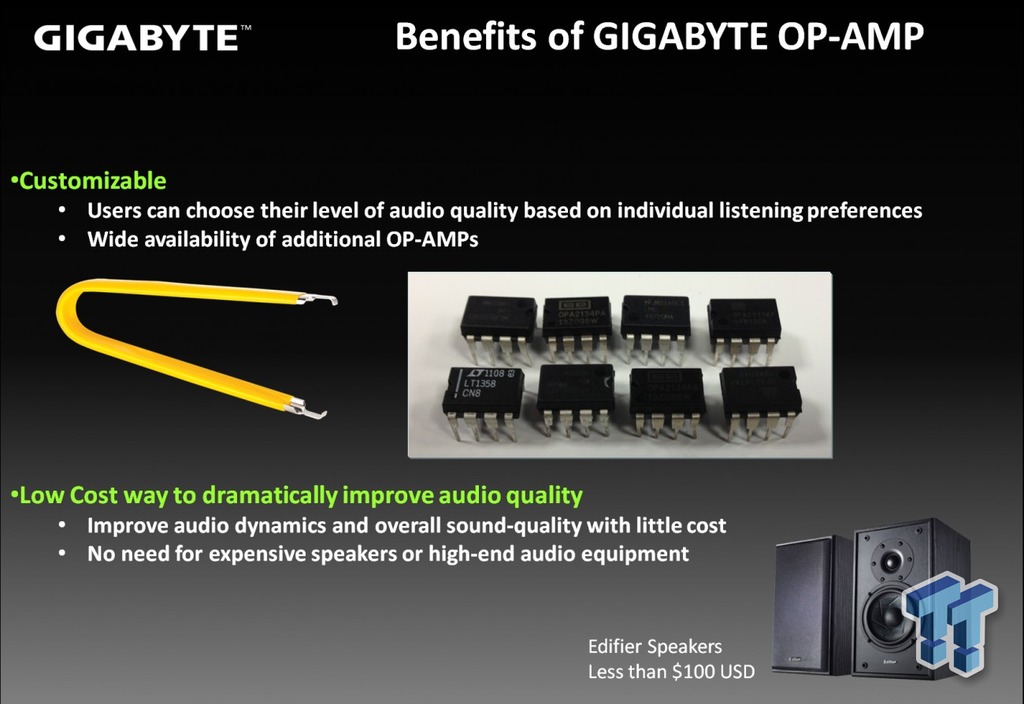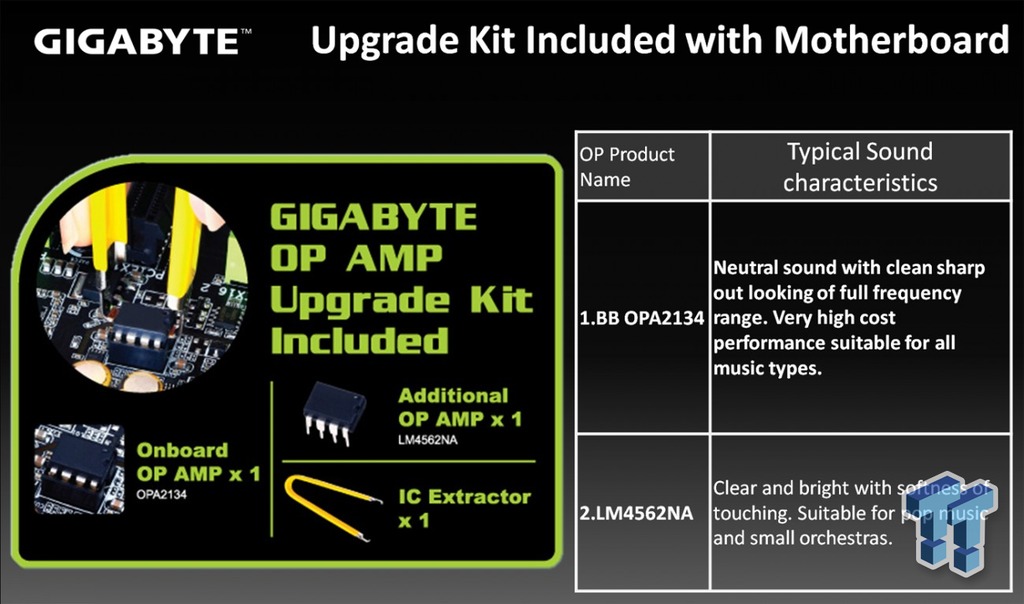Gigabyte Shows Off High-End Onboard Audio for Z87 G1-Sniper 5/M5 With Replaceable OP-Amps
More details have come to light regarding Gigabyte's flagship Z87 motherboards
Gigabyte has demonstrated its G1.Sniper 5 and G1.Sniper M5 motherboards, which are Z87 motherboards intended for Intel’s upcoming 4th generation processors. The motherboards have many high-end features, but Gigabyte put a lot of emphasis on the removable operational amplifiers that the motherboards feature for their onboard audio.
The onboard audio on the G1.Sniper 5 and G1.Sniper M5 motherboards is supported by a Creative Sound Core 3D chip, as we saw in an earlier teaser. The chip itself is covered in a gold-coated cover, and all the media-related connectors are also gold coated (2x HDMI, Coax, Displayport, and the analogue 7.1 audio ports). Taking a closer look at the motherboard reveals a green line that separates the audio dedicated part of the PCB from the rest of the motherboard, and in between, you find a small distance, likely to reduce interference. Supposedly, this green line is lit. As mentioned, the most emphasis is put on the replaceable op-amps, which allows the user to remove the stock operational amplifier and replace it with something that suits their needs more closely. While most users won't mind using the stock op-amp, Asus' Essence STX sound card showed us that there is a market for people who wish to replace the op-amps. The motherboards will even come with an upgrade kit for the op-amps which includes an LM4562NA op-amp and an IC extractor.
Beyond all this, the two motherboards carry a number of gaming-oriented features. The G1.Sniper 5 is a full-ATX motherboard that features four PCIe x16 3.0 slots, which can be wired as x16/-/x16/- or x16/-/x8/x8 or x8/x8/x16/- or x8/x8/x8/x8, all depending on how you install the graphics cards that you use. The PLX PEX8747 48-lane PCI-Express 3.0 bridge chip makes this possible. The G1.Sniper 5 is also the liquid cooled motherboard from Gigabyte that we saw earlier.
Then we have the G1.Killer M5, which is essentially a smaller brother of the G1.Sniper M5 in a micro-ATX system. It features two electrical PCIe x16 3.0 slots, but does not have the PCIe 3.0 bridge chip. Therefore, the user can install either a single graphics card that will run over 16 lanes, or two graphics cards that will each be fed eight lanes. It also has the AMP-UP audio with the Creative Sound Core 3D chip.
Images courtesy of TweakTown and HardwareHeaven.
Get Tom's Hardware's best news and in-depth reviews, straight to your inbox.
Niels Broekhuijsen is a Contributing Writer for Tom's Hardware US. He reviews cases, water cooling and pc builds.
-
mousseng Hmm, seems motherboard manufacturers are stepping up their game in response to the increasing number of integrated components, maybe? I figured it'd be difficult to differentiate themselves more and more, but it appears they're doing fine for now. I'd really love to use this one in particular for a high-end gaming rig!Reply -
vmem make a version that's not black and green and I'll buy it... keep the current one, I know it's special in its own way, but honestly, unless you have an Nvidia fanboi themed PC, that board would look out of place with everything else...Reply -
razor512 I have tried sound cards with a replaceable op amp and you generally cant tell any difference. While I am sure you may see something if you run it through an oscilloscope, but Nothing that at least a pair of a $100-120 headphone can detect.Reply
What sets a soundcard apart, is how well it can process the audio.
For example back in the day, when the audigy 2 ZS cards, The EAX console really improved audio quality as it not only allowed you to improve certain levels of the headphones, eg boosting the bass, and balancing out the audio to try to get a flatter response. It was able to prevent clipping and other issues which were common with onboard audio at the time, and even today.
eg the audio in my audigy 2 ZS is still better than the onboard audio on my gigabyte 990FXA-UD3 board. (especially with the modded drivers which brings back some of the features that the card had with windows xp.
(pretty good for a card that I have been using for nearly 10 years through all of my PC builds)
For the replaceable op amp asus has cards like that, and I tried them and was unable to tell any difference. -
tonicipriani Looks like Gigabyte still doing the 8-4-16 split on the M5 like on the M3 instead of the 4-8-16 split on the Asus Gene V. There's practically no way to use 8x-8x SLI on this board without using a full ATX case, which defeats the purpose of MicroATX in the first place.Reply -
Thorfkin I wish more companies would released decent boards with an on-board Creative Labs audio chip-sets. About two weeks I go I was looking for an decent new motherboard to upgrade my home theater PC. I was specifically looking for an enthusiast level board with a creative labs 7.1 audio chipset to make best possible use of my home theater sound system. Unfortunately I just couldn't find anything. I ended up going with a Sabertooth 990FX from Asus' Tuf series. The 7.1 realtek chipset will do well enough but I really would have been happier with something higher end for audio.Reply -
Thorfkin, you know that one company that offer SOUND BLASTER onboard for their motherboard is MSI right? You should check out their Z77 models and I'm sure their upcoming models Z87 haswell socket will have them too.Reply
-
universal remonster Reply10750858 said:I wish more companies would released decent boards with an on-board Creative Labs audio chip-sets. About two weeks I go I was looking for an decent new motherboard to upgrade my home theater PC. I was specifically looking for an enthusiast level board with a creative labs 7.1 audio chipset to make best possible use of my home theater sound system. Unfortunately I just couldn't find anything. I ended up going with a Sabertooth 990FX from Asus' Tuf series. The 7.1 realtek chipset will do well enough but I really would have been happier with something higher end for audio.
I'm assuming that as a home theater PC you are hooking it up with either HDMI or optical out to a receiver, in which case a sound card (or even on board audio) does nothing. A digital signal bypasses any internal processing and is passed through to your receiver where all decode/processing takes place. Sound cards only process the signal when using their analog outputs, so people using headphones or powered speakers that plug into the 1/8th inch jacks make use of them. I just wanted to let you know, I'd hate to see someone spend good money on a soundcard when it would yield zero difference compared to an onboard optical output or HDMI out of your video card.





